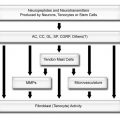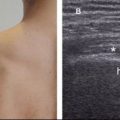3. Terminology
A consensual terminology is lacking and numerous terms are used interchangeably to describe disorders of the LHBBT, including tendinitis, tendonitis, tendinosis, tendinopathy, and tenosynovitis. When assessing the extra-articular portion of the tendon, we use the term tenosynovitis to designate (1) normal tendons surrounded by increased fluid or proliferating synovium and (2) thickened and hypoechoic tendons surrounded by normal fluid. At US, tenosynovitis does not show well-defined defects or fiber discontinuity, and these findings suggest a tear. Care must be taken to differentiate communicating joint effusion from tenosynovitis as the cause of sheath distension (see section 5.1).
We prefer tenosynovitis over other terminologies because it is more popular, even though the suffix –itis overemphasizes the inflammatory component of an entity that also has degenerative elements. Histopathologically, tenosynovitis is characterized by chronic inflammation, fibrotic degeneration, a decrease in the number of axons in the distal portion of the tendon, and an increase in the calcitonin gene-related peptide and substance P within associated nerve roots and blood vessels.19,20 In this book, as in sonographic reports, we use the term tenosynovitis as a descriptive, not histopathological diagnosis.
Stay updated, free articles. Join our Telegram channel

Full access? Get Clinical Tree





